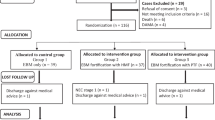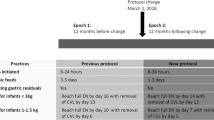Abstract
Optimal feeding of low birth weight (LBW) infants improves their immediate survival and subsequent growth and development. Being a heterogeneous group comprising term and preterm neonates, their feeding abilities, fluid and nutritional requirements are quite different from normal birth weight infants. A practical approach to feeding a LBW infant including choice of initial feeding method, progression of oral feeds, and nutritional supplementation based on her oral feeding skills and nutritional requirements is being discussed in this protocol. Growth monitoring, management of feed intolerance, and the essential skills involved in feeding them have also been described in detail.
Similar content being viewed by others
References
UNICEF. State of the World’s Children 2005. New York: UNICEF, 2004.
Bang A, Reddy MH, Deshmukh MD. Child mortality in Maharashtra. Economic Political weekly 2002; 37: 4947–4965.
Edmond KM, Kirkwood BR, Tawiah CA, Agyei SO. Impact of early infant feeding practices on mortality in low birth weight infants from rural Ghana. J Perinatol 2008; [Epub ahead of print]
Levitsky DA, Strupp BJ. Malnutrition and the brain: changing concepts, changing concerns. J Nutr 1995; 125: 2212S–2220S.
Omari TI, Rudolph CD. Gastrointestinal Motility. In: Polin RA and Fox WW eds. Fetal and Neonatal Physiology, 2nd ed. Philadelphia, WB Saunders Co, 1998; 1125–1138.
Anonymous. Feeding. In Deorari AK, Paul VK, Scotland J, McMillan DD, Singhal N eds. Practical Procedures for the Newborn Nursery, 2nd ed. New Delhi, Sagar Publishers, 2003: 71–78.
Stocks J. Effect of nasogastric tubes on nasal resistance during infancy. Arch Dis Child 1980; 55: 17–21.
Premji SS, Chessell L. Continuous nasogastric milk feeding versus intermittent bolus milk feeding for premature infants less than 1500 grams. Cochrane Database of Systematic Reviews 2001, Issue 1. Art. No.: CD 001819.
DeVille KT, Shulman RJ, Berseth CL. Slow infusion feeding enhances gastric emptying in preterm infants compared to bolus feeding. Clin Res 1993; 41: 787A.
Mishra S, Agarwal R, Jeevasankar M, Deorari AK, Paul VK. Minimal enteral nutrition. Indian J Pediatr 2008; 75: 267–269.
Dorling J, Kempley S, Leaf A. Feeding growth restricted preterm infants with abnormal antenatal Doppler results. Arch Dis Child Fetal Neonatal Ed 2005; 90: F359–F363.
Chawla D, Agarwal R, Deorari AK, Paul VK. Fluid and electrolyte management in term and preterm neonates. Indian J Pediatr 2008; 75: 255–259.
Annonymous. Nutrition. In Edmond K, Bahl R, eds. Optimal feeding of law-birth weights infnats — Technical Review. World Health Organization 2006; 42.
Abrams SA. Abnormalities of serum calcium and magnesium. In Cloherty JP, Eichenwald EC, Stark AR eds. Manual of Neonatal Care. 6th ed. Philadelphia: Lippincott Williams & Wilkins 2008; p558.
American Academy of Pediatrics Committee on Nutrition: Nutritional needs of preterm infants. In Kleinman RE ed. Pediatric Nutrition Handbook American Academy of Pediatrics. Elk Grove Village, IL, American Academy of Pediatrics, 2004; 23–54.
Schanler RJ, Garza C. Improved mineral balance in very low birth weight infants fed fortified human milk. J Pediatr 1987; 112: 452–456.
Kuschel CA, Harding JE. Multicomponent fortified human milk for promoting growth in preterm infants. Cochrane Database of Systematic Reviews 1998, Issue 4. Art. No.: CD 000343.
Mukhopadhyay K, Narnag A, Mahajan R. Effect of human milk fortification in appropriate for gestation and small for gestation preterm babies: a randomized controlled trial. Indian Pediatr 2007; 44: 286–290.
Schanler RJ. Enteral Nutrition for the High-Risk Neonate. In Taeusch HW, Ballard RA, Gleason CA eds. Avery’s Diseases of the Newborn, 8th ed. Philadelphia, Saunders, 2005; 1043–1060.
Wright K, Dawson JP, Fallis D, Vogt E, Lorch V. New postnatal growth grids for very low birth weight infants. Pediatrics 1993; 91: 922–926.
Ehrenkranz RA, Younes N, Lemons JA, Fanaroff AA, Donovan EF, Wright LL et al. Longitudinal growth of hospitalized very low birth weight infants. Pediatrics 1999; 104: 280–289.
Author information
Authors and Affiliations
Corresponding author
Rights and permissions
About this article
Cite this article
Jeeva Sankar, M., Agarwal, R., Mishra, S. et al. Feeding of low birth weight infants. Indian J Pediatr 75, 459–469 (2008). https://doi.org/10.1007/s12098-008-0073-y
Received:
Accepted:
Issue Date:
DOI: https://doi.org/10.1007/s12098-008-0073-y




